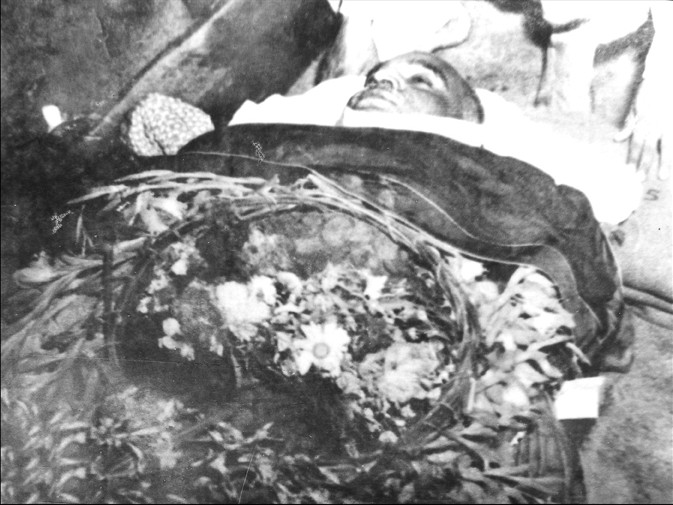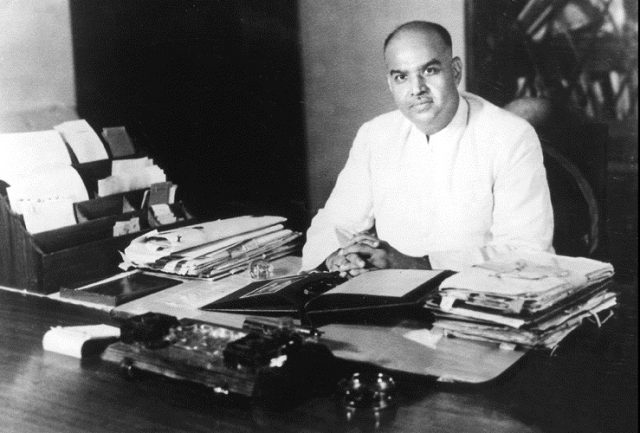Shyama Prasad Mukherjee was an Indian Politician, barrister and academician, who served as the Minister of Industry and Supply in Prime Minister Jawaharlal Nehru’s Cabinet. After falling out with Nehru, protesting against Nehru-Liaquat pact, Mukherjee resigned from the Nehru’s cabinet. With the help of Rashtriya Swayamsevak Sangh (RSS), he founded the Bharatiya Jana Sangh (BJS), the predecessor to the Bharatiya Janta Party (BJP), in 1951. He was also the president of Akhil Bharatiya Hindu Mahasabha from 1943 to 1946. He died in the custody of Jammu and Kashmir Police in 1953. He was provisionally diagnosed of a heart attack and shifted to a hospital but died a day later. Since the Bharatiya Janta Party is the successor to the Bharatiya Jana Sangh, Mukherjee is also regarded as the founder of Bharatiya Janta Party.

Personal Life-
Shyama Prasad Mukherjee was born in a Bengali Hindu Brahmin family on 6th July 1901 in Calcutta. His father was Ashutosh Mukherjee, a judge of the High Court of Calcutta, Bengal, who was also Vice-Chancellor of the University of Calcutta. His mother was Jogamaya Devi Mukherjee. He was enrolled in Bhawanipur’s Mitra Institution in 1906 and his behavior in school was later described favorably by his teachers. In 1914, he passed and his Matriculation examination and was admitted into Presidency College. He stood seventeenth in the Inter Arts Examination in 1916 and graduated in English, securing the first position in first class in 1921. He was married to Sudha Devi on 16th April 1922. Mukherjee also completed and MA in Bengali, being graded as first class in 1923 and also became a fellow of the senate in 1923. He completed his BL in 1924. He enrolled as an advocate in the Calcutta High Court in 1924, the same year in which his father had died. Subsequently, he left for England in 1926 to study at Lincoln’s Inn and was called to the English Bar in the same year.
Political Career before independence-
Mukherjee started his political career in 1929, when he entered the Bengal Legislative Council as an Indian National Congress (INC) candidate representing Calcutta University. However, he resigned the next year when the INC decided to boycott the legislature. Subsequently, he contested the election as an Independent candidate and was elected in the same year. In 1937, he was elected as an independent candidate in the elections which brought the Krishak Praja Party-All India Muslim League coalition to power. He served as the Finance Minister of Bengal Province in 1941-42 under A.K.Fazlil Haq’s Progressive Coalition government which was formed on 12th December 1941 after the resignations of the Congress Government. During his tenure, his statements against the government were censored and his movements were restricted. He was also prevented from visiting the Midnapore District in 1942 when severe floods caused heavy loss of life and property. He resigned on 20th November 1942 accusing the British Government of trying to hold on to India under any cost and criticized its repressive policies against the Quit India Movement. After resigning, he mobilized support and organized relief with the help of Mahabodhi Society, Ramakrishna Mission and Marwari Relief Society. In 1946, he was again elected as an independent candidate for the Calcutta University. He was elected as a member of the Constituent Assembly of India in the same year. Mukherjee joined the Hindu Mahasabha in Bengal in 1939 and became its acting president the same year. He was appointed as the working president of the organization in 1940. In February 1941, Mukherjee told a Hindu rally that if Muslims wanted to live in Pakistan they should “pack their bags and baggage and leave India to wherever they like”. He was elected as the President of Akhil Bharatiya Hindu Mahasabha in 1943. He remained in this position till 1946, with Laxman Bhopatkar becoming the new President in the same year. Mukherjee demanded the partition of Bengal in 1946 to prevent the inclusion of Hindu-majority areas in a Muslim-dominated East Pakistan. A meeting was held by the Mahasabha on 15th April 1947 in Tarakeswar authorized him to take steps for ensuring the partition of Bengal. In May 1947, he wrote a letter to Lord Mountbatten telling him that Bengal must be partitioned even if India was not. He also opposed a failed bid for a united but independent Bengal made in 1947 by Sarat Bose, the bother of Subhas Chandra Bose, and Huseyn Shaheed Suhrawardy, a Bengali Muslim politician. His views were strongly affected by the Noakhali Genocide in East Bengal, where mobs belonging to the Muslim League massacred Hindus. The Hindu Mahasabha also opposed the Quit India Movement and decided not to take part in the movement.

Political Career after independence :
Prime Minister Jawaharlal Nehru inducted Mukherjee into the Interim Central Government as a Minister of Industry and Supply on 15 August 1947. Mukherjee began to have differences with Mahasabha after the assassination of Mahatma Gandhi, in which the organization was blamed by Sardar Patel for creating the atmosphere that led to the killing. Mukherjee suggested the organization suspend its political activities. Shortly, after it did, in December 1948, he left. One of his reasons was the rejection of his proposal to allow non-Hindus to become members. Mukherjee resigned along with K.C. Neogy from the cabinet on 8th April 1950 over a disagreement about the 1950 Delhi Pact with Pakistan Prime Minister Liaquat Ali Khan. Mukherjee was firmly against their joint pact to establish minority commissions and guarantee minority rights in both countries as he thought it left Hindus in East Bengal to the mercy of Pakistan.
While addressing a rally in Calcutta on 21 May, he stated that an exchange of population and property at governmental level on regional basis between East Bengal and the states of Tripura, Assam, West Bengal and Bihar was the only option in the current situation. Mukherjee founded the Bharatiya Jana Sangh on 21st October 1951 in Delhi, becoming its first president. In the 1952 elections, the Bharatiya Jana Sangh (BJS) won three seats in the Parliament of India, including Mukherjee’s. He has formed the National Democratic Party within the Parliament. It consisted of 32 members of the Lok Sabha and 10 members of the Rajya Sabha; however, it was not recognized by the speaker as an opposition party. The BJS was created with the objective of Nation-building and “nationalizing” all non-Hindus by “inculcating Bharatiya culture” in them. The party was ideologically close to the RSS and widely considered the proponent of Hindu Nationalism.

His opinion on Kashmir :
Mukherjee was strongly opposed to Article 370, seeing it as a threat to national unity. He fought against it inside and outside the parliament with one of the goals of Bharatiya Jana Sangh being it abrogation. He raised his voice strongly against the provision in his Lok Sabha speech on 26th June 1952. He termed the arrangements under the Article as Balkanization of India and the three-nation theory of Sheikh Abdullah. The state was granted its own flag along with a prime minister whose permission was required for anyone to enter the state. In opposition to this, Mukherjee once said “Ek desh mein do Vidhan, do Pradhan aur Do Nishan nahi chalenge” (A single country can’t have two constitutions, two Prime Ministers and two National Emblems). Bharatiya Jana Sangh along with Hindu Mahasabha and Jammu Praja Parishad launched a massive Satyagraha to get the provisions removed. In his letter to Nehru dated 3rd February 1953, he wrote that the issue of accession of Jammu and Kashmir to India should not be allowed to hang fire. Mukherjee went to visit Kashmir in 1953 and observed a hunger strike to protest the law that prohibited Indian citizens from settling within the state and mandating that they carry ID cards. Mukherjee wanted to go to Jammu and Kashmir but, because of the prevailing system, he was not given permission. He was arrested on 11th May at Lakhanpur while crossing the border into Kashmir illegally. The ID card request was later revoked owing to his request. On 5th August 2019, when the Government of India proposed constitutional Amendment to repeal Article 370, many newspapers described the event as the realization of Shyama Prasad Mukherjee’s dream.

Mysterious Death :
Mukherjee was arrested upon entering Kashmir on 11th May 1953. He and two of his arrested companions were first taken to the Central Jail of Srinagar. Later, they were transferred to a cottage outside the city. Mukherjee’s conditions started deteriorating and he started feeling pain in the back and high temperature in the night between 19th and 20th June. He was diagnosed with dry pleurisy from which he had also suffered in 1937 and 1944. He was later shifted to a hospital on 22nd June when he felt pain on his chest. He was provisionally diagnosed of a heart attack. He died a day later. The state government declared that he had died on 23rd June at 3:40 am due to a heart attack.

His death in custody raised wide suspicion across the country and demands for an independent inquiry were raised, including earnest requests from his mother, Jogamaya Devi, to Nehru. The Prime Minister declared that he had asked a number of people who had privy to the facts, and according to him, there was no mystery behind Mukherjee’s death. Devi did not accept Nehru’s reply and requested an impartial inquiry. Nehru, however, ignored the letter and no inquiry commission was set up. Mukherjee’s death, therefore, remains a matter of controversy. S.C. Das claims that Mukherjee was murdered. Atal Bihari Vajpayee claimed in 2004 that the arrest of Mukherjee in Jammu and Kashmir was a “Nehru Conspiracy”.
